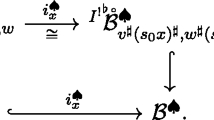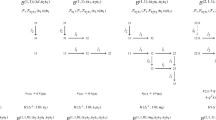Abstract
In this paper we start the study of configurations of flags in closed orbits of real forms using mainly tools of GIT. As an application, using cross ratio coordinates for generic configurations, we identify boundary unipotent representations of the fundamental group of the figure eight knot complement into real forms of \({{\,\mathrm{PGL}\,}}(4,{\mathbb {C}})\).







Similar content being viewed by others
Notes
The quotient \(Y/{\mathfrak {S}}_r\) is described by the ring of invariants of binary quantics: it is the ring of polynomials in the variables \(a_0, \ldots , a_r\) that are invariant under the action of \({{\,\mathrm{SL}\,}}_2({\mathbb {C}})\) on \({\mathbb {C}}[a_0, \ldots , a_r]\) defined by \((g\cdot f)(x,y) = f(g^{-1}(x,y))\) where \(g \in {{\,\mathrm{SL}\,}}_2({\mathbb {C}})\) and \(f = \sum _i a_i x^{r-i} y^i\).
Indeed, semi-stability only depends on the orbit under \(G({\mathbb {C}})\).
To a quaternion \(q = a + bi + cj +dk \in {\mathbb {H}}\) one can associate the \(2 \times 2\) matrix with complex entries
$$\begin{aligned} m(q) := \begin{pmatrix} a + bi &{}\quad c + di \\ -c +di &{}\quad a - bi \end{pmatrix}. \end{aligned}$$This induces an isomorphism of non-commutative \({\mathbb {C}}\)-algebras \(m :H \otimes _{\mathbb {R}}{\mathbb {C}}\rightarrow {{\,\mathrm{End}\,}}({\mathbb {C}}^2)\). A \(2 \times 2\) matrix with quaternionic coefficients,
$$\begin{aligned} \begin{pmatrix} q_1 &{}\quad q_2 \\ q_3 &{}\quad q_4\end{pmatrix} \in {{\,\mathrm{GL}\,}}_2({\mathbb {H}}) \end{aligned}$$belongs to \({{\,\mathrm{SL}\,}}_2({\mathbb {H}})\) if and only if the associated \(4 \times 4\) matrix with complex coefficients,
$$\begin{aligned} \begin{pmatrix} m(q_1) &{}\quad m(q_2) \\ m(q_3) &{}\quad m(q_4) \end{pmatrix}, \end{aligned}$$has determinant 1. If \(q_1 \ne 0\) this is equivalent to saying that the norm of \(q_1 q_4 - q_1 q_3 q_1^{-1} q_2\) is 1.
That is, for every \(x \in U({\mathbb {C}})\), the closure of the orbit \(G({\mathbb {C}}) \cdot x\) is contained in \(U({\mathbb {C}})\).
As already mentioned in the Introduction, a competing symbol in the literature is \(X /\!\!/ G\).
That is, for every \(x \in U({\mathbb {R}})\) the closure of the orbit \(G({\mathbb {R}}) \cdot x\) is contained in \(U({\mathbb {R}})\).
Under this correspondence \(L = \iota ^*{\mathcal {O}}(1)\) and \(V = {{\,\mathrm{H}\,}}^0(X, L)^\vee \).
Again in the literature it can be denoted \(X /\!\!/ G\) or \(X^{\text {ss}}/\!\!/ G\).
This follows from the fact that the representations of G are completely reducible.
One could argue by remarking that \(\frac{1}{d} A\) is a doubly stochastic matrix. The Birkhoff–von Neumann theorem therefore states that \(\frac{1}{d} A\) is a convex combination of permutation matrices. It follows that A can be written as a sum
$$\begin{aligned} A = \sum _{\sigma \in {\mathfrak {S}}_r} \lambda _\sigma A_\sigma , \end{aligned}$$where for a permutation \(\sigma \in {\mathfrak {S}}_r\), \(A_\sigma \) is the associated permutation matrix and \(\lambda _\sigma \) is a non-negative real number. Nonetheless it is not clear that the coefficients \(\lambda _\sigma \) can be taken as integers (the decomposition is not unique).
Given \(g \in P_1 \cap P_2\) and \(h \in {{\,\mathrm{rad}\,}}^u(P_1)\) one has to find the unique element \(h' \in {{\,\mathrm{rad}\,}}^u(P_1)\) such that \( gh \cdot W_2 = h' \cdot W_2\). Since g belongs to stabilizer of \(W_2\) by hypothesis, \( gh \cdot W_2 = ghg^{-1} \cdot W_2\). On the other hand \(ghg^{-1}\) belongs to \({{\,\mathrm{rad}\,}}^u(P_1)\) because the unipotent radical is a normal subgroup of \(P_1\). Thus \(h ' = ghg^{-1}\).
This can be seen as follows. Write q as a matrix
$$\begin{aligned} A= \begin{pmatrix} a &{}\quad - {\bar{b}} \\ b &{}\quad {\bar{a}}\end{pmatrix}, \end{aligned}$$with \(a, b \in {\mathbb {C}}\). The matrix A commutes with its adjoint, thus there is an orthonormal basis of \({\mathbb {C}}^2\) made of eigenvectors. In other words there exists \(U \in {{\,\mathrm{U}\,}}(2)\) and \(\lambda \in {\mathbb {C}}\) such that
$$\begin{aligned} U A U^{-1} = \begin{pmatrix} \lambda &{}\quad 0 \\ 0 &{}\quad {\bar{\lambda }}\end{pmatrix}. \end{aligned}$$This is essentially the proof of (2) in the preceding Proposition.
References
Atiyah, M., Bott, R., Patodi, V.K.: On the heat equation and the index theorem. Invent. Math. 19, 279–330 (1973)
Bergeron, N., Falbel, E., Guilloux, A.: Tetrahedra of flags, volume and homology of \({{\rm SL}}(3)\). Geom. Topol. 18(4), 1911–1971 (2014)
Bisi, C., Gentili, G.: Möbius transformations and the Poincaré distance in the quaternionic setting. Indiana Univ. Math. J. 58(6), 2729–2764 (2009)
Birkes, D.: Orbits of linear algebraic groups. Ann. Math. (2) 93, 459–475 (1971)
Borel, A.: Linear Algebraic Groups, Graduate Texts in Mathematics, vol. 126, 2nd edn. Springer, New York (1991)
Ballas, S.A., Paupert, J., Will, P.: Rank 1 deformations of non-cocompact hyperbolic lattices. arXiv:1702.00508 (2017)
Curve (computing and understanding representation varieties efficiently). http://curve.unhyperbolic.org
Dimofte, T., Gabella, M., Goncharov, A.B.: K-decompositions and 3D gauge theories. J. High Energy Phys. 11, 151 (2016). front matter+144
Falbel, E.: A spherical CR structure on the complement of the figure eight knot with discrete holonomy. J. Differ. Geom. 79(1), 69–110 (2008)
Falbel, E., Platis, I.D.: The PU(2,1) Configuration space of four points in S3 and the cross-ratio variety. Math. Ann. 340(4), 935–962 (2008)
Fock, V.V., Goncharov, A.B.: Moduli spaces of convex projective structures on surfaces. Adv. Math. 208(1), 249–273 (2007)
Falbel, E., Koseleff, P.-V., Rouillier, F.: Representations of fundamental groups of 3-manifolds into \(PGL(3,{\mathbb{C}})\): exact computations in low complexity. Geom. Dedicata 177, 229–255 (2015)
Falbel, E., Santos Thebaldi, R.: A flag structure on a cusped hyperbolic 3-manifold. Pac. J. Math. 278(1), 51–78 (2015)
Garoufalidis, S., Goerner, M., Zickert, C.K.: Gluing equations for \(PGL(n,{\mathbb{C}})\)-representations of 3-manifolds. Algebr. Geom. Topol. 15(1), 565–622 (2015)
Gwynne, E., Libine, M.: On a quaternionic analogue of the cross-ratio. Adv. Appl. Clifford Algebr. 22(4), 1041–1053 (2012)
Howard, B., Millson, J., Snowden, A., Vakil, R.: The ideal of relations for the ring of invariants of \(n\) points on the line. J. Eur. Math. Soc. (JEMS) 14(1), 1–60 (2012)
Halmos, P.R., Vaughan, H.E.: The marriage problem. Am. J. Math. 72, 214–215 (1950)
Kempf, G.R.: Instability in invariant theory. Ann. Math. (2) 108(2), 299–316 (1978)
Luna, D.: Slices étales, Sur les groupes algébriques, Soc. Math. France, Paris, pp. 81–105. Bull. Soc. Math. France, Paris, Mémoire 33 (1973)
Luna, D.: Sur certaines opérations différentiables des groupes de Lie. Am. J. Math. 97, 172–181 (1975)
Luna, D.: Fonctions différentiables invariantes sous l’opération d’un groupe réductif. Ann. Inst. Fourier (Grenoble) 26(1, ix), 33–49 (1976)
Moret-Bailly, L.: Un théorème de l’application ouverte sur les corps valués algébriquement clos. Math. Scand. 111(2), 161–168 (2012)
Mumford, D., Suominen, K.: Introduction to the theory of moduli. In: Algebraic Geometry. Oslo 1970 (Proceedings of Fifth Nordic Summer-School in Mathematics), pp. 171–222. Wolters-Noordhoff, Groningen (1972)
Mumford, D., Fogarty, J., Kirwan, F.: Geometric Invariant Theory, 3rd ed., Ergebnisse der Mathematik und ihrer Grenzgebiete (2) [Results in Mathematics and Related Areas (2)], vol. 34. Springer, Berlin (1994)
Rousseau, G.: Instabilité dans les espaces vectoriels. In: Algebraic Surfaces (Orsay, 1976–78), Lecture Notes in Math., vol. 868, pp. 263–276. Springer, Berlin (1981)
Richardson, R.W., Slodowy, P.J.: Minimum vectors for real reductive algebraic groups. J. Lond. Math. Soc. (2) 42(3), 409–429 (1990)
Serre, J.-P.: Géométrie algébrique et géométrie analytique. Ann. Inst. Fourier Grenoble 6, 1–42 (1955–1956)
Serre, J.-P.: Cohomologie galoisienne, 5th ed., Lecture Notes in Mathematics, vol. 5. Springer, Berlin (1994)
Wolf, J.A.: The action of a real semisimple group on a complex flag manifold. I. Orbit structure and holomorphic arc components. Bull. Am. Math. Soc. 75, 1121–1237 (1969)
Acknowledgements
We thank Claudio Gorodski, Antonin Guilloux, Greg Kuperberg and Maxime Wolff for several discussions.
Author information
Authors and Affiliations
Corresponding author
Additional information
Publisher's Note
Springer Nature remains neutral with regard to jurisdictional claims in published maps and institutional affiliations.
The third author is partially supported by INDAM-GNSAGA, by the 2014 SIR Grant Analytic Aspects in Complex and Hypercomplex Geometry and by Finanziamento Premiale FOE 2014 Splines for accUrate NumeRics: adaptIve models for Simulation Environments of the Italian Ministry of Education (MIUR). Part of this project has been developed while she was an INdAM-COFUND fellow at IMJ-PRG Paris.
Rights and permissions
About this article
Cite this article
Falbel, E., Maculan, M. & Sarfatti, G. Configurations of flags in orbits of real forms. Geom Dedicata 207, 95–156 (2020). https://doi.org/10.1007/s10711-019-00489-3
Received:
Accepted:
Published:
Issue Date:
DOI: https://doi.org/10.1007/s10711-019-00489-3




